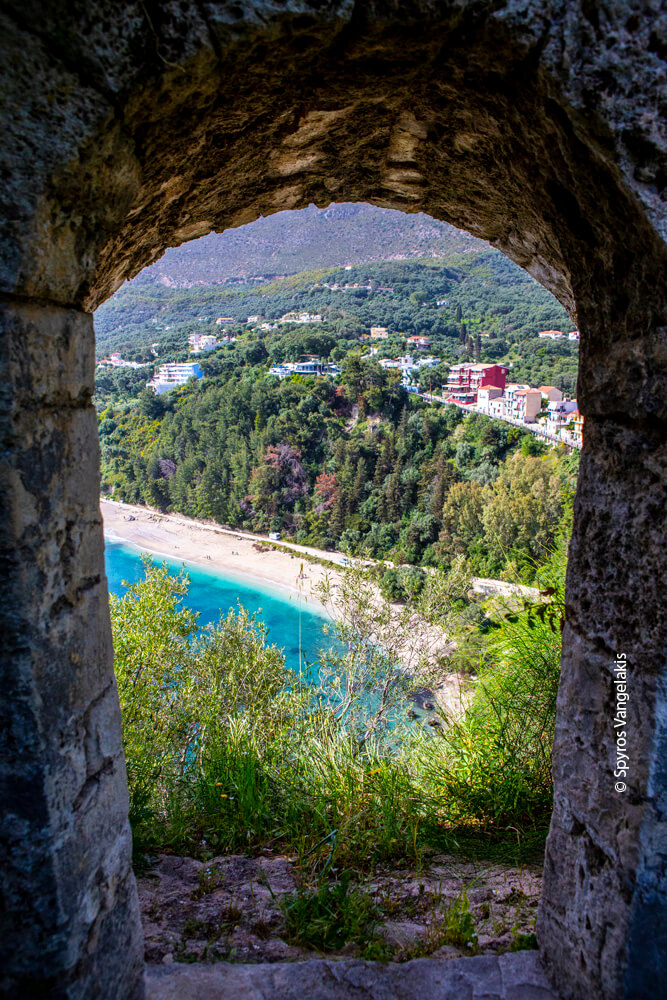Parga Castle is a medieval castle at the top of Parga in Epirus. Located on top of a hill overlooking the city, it has been an important landmark since the 15th century, partly because of the strong fortifications used to protect the city from raids by land and sea.
It is strategically located on a rocky peninsula overlooking the sea on three sides and the city on the other.
In ancient times the area around the castle was inhabited by the Greek tribe of Thesprotes. The ancient city of Turin was probably located here. Before the castle of Parga (which survives today) was built, the inhabitants of Parga tried to maintain the fortified city, which was exposed to the sea, in order to face the invaders. In this effort they had built the first fortifications with the help of the Normans initially in the 11th century by the inhabitants of Parga to protect their city from the pirates and later the Ottomans. In the 15th century, as Ottoman control of the area increased, the Venetians rebuilt the castle to fortify the area.
The city and its castle were unsuccessfully offered by Nicholas Orsini, the Despot of Epirus, to the Republic of Venice in exchange for Venetian aid against the Byzantine Empire. During the Epirus rebellion of 1338/39 against the Byzantine emperor Andronikos III Palaiologos, Parga remained loyal to the emperor. In the 1390s it was under the rule of Ioannis Buis, lord of Arta.
The city finally came under Venetian control in 1401 and was administered as a mainland extension of the Venetian occupation of Corfu, under the castellano. Venetian occupation was confirmed by the Ottoman-Venetian treaty of 1419. Apart from brief periods of Ottoman occupation, the city remained in Venetian hands until the fall of the Republic of Venice in 1797.
In 1452, Parga and the fortified position were occupied by Hadji Bey for two years. Part of the castle was demolished at that time. In 1537, the Ottoman admiral Haireddin Barbarossa burned and destroyed the fortress and the houses in it. Before the castle was rebuilt in 1572 by the Venetians, the Turks demolished it once again. The castle was rebuilt with the help of the Venetians, but before it was completed it was again demolished by the Turks.
An inscription above the outer gate dates the construction of this part of the wall to 1707, by Count Markos Teototsi, governor and captain of Parga.
In 1792, the Venetians began construction of the third and final fortress, with work completed in 1808 by the French during their stay in the wider area between 1797 and 1814. The castle was not conquered until 1819, despite the attacks mainly by Ali Pasha of Ioannina who besieged the castle.
In 1815, with the fall of French power, the citizens of Parga revolted against French rule and demanded British protection. In 1819, the British sold the city to Ali Pasha, under wider Ottoman rule. Ali Pasha made structural additions to the castle, including strengthening the existing walls, installing his harem and building a hammam with the structure, and radically remodeling the castle grounds. In 1823 Ali Pasha was assassinated and from him the castle came under direct Ottoman rule.
Ottoman rule over Parga and the rest of Epirus ended in 1913 after Greece’s victory in the Balkan Wars and it came under the control of the Greek state.
In 2020, cleaning and restoration work was carried out by the Municipality and the Municipal Community of Parga under the supervision of the Ephorate of Antiquities of Preveza.
The Venetians created a perfect defensive plan which together with the physical fortification made it an impregnable fortress. Outside the castle, eight towers in various locations completed the defences. Inside the narrow space of the citadel were piled 400 houses, in such a way that they occupied a small space, untouched by the sea.
The castle’s cisterns and houses were supplied with water from the “Kremasma” fountain. The castle used the two bays for supplies: Valtos and Pogonia. The castle of Parga was invincible throughout the administration of Ali Pasha and supported the Souliotes who resisted him.
The castle of Parga is accessible via narrow streets and steps from the port of Parga and there is a paved road leading to the beach of Valtos.
In the arched entrance gate, the winged lion of Saint Mark, the name “ANTONIO CERVASS 1764”, emblems of Ali Pasha, double-headed eagles and related inscriptions can be seen on the wall. Vaulted corridors, shooting rooms, supply arcades, strong bastions with guns, light weapons, barracks, prisons, warehouses and two forts as the last line of defense.
An inscription above a stone door (next to the powder magazine) reads: Défense de la Patrie A. D. 1808.
Daily 10:30, 12:15
Adults 6 €
Kids 3 €
Kids up to 6 years Free

Copyright 2023 PargaTrains © | Developed by Cactus